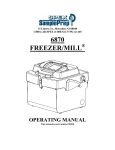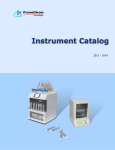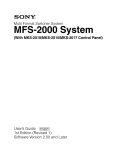Download User Manual
Transcript
15 Liberty St., Metuchen, NJ 08840 1-855-GET-SPEX (1-438-7739) Ext. 465 www.spexsampleprep.com 2010 Geno/Grinder® Patented OPERATING MANUAL For 2010-115 and 2010-230 Geno/Grinders, this manual is Part No. 87036 2010 Geno/Grinder Copyright 2013 by SPEX SamplePrep LLC All rights reserved. No part of the work may be reproduced or transmitted in any form or by any means, electronic or mechanical; including photocopying and recording, except as may be expressly permitted by the 1976 Copyright Act or in writing from the publisher. Requests for permission should be addressed in writing to SPEX SamplePrep LLC, 15 Liberty Street, Metuchen, NJ 08840. Page 2 of 28 SPEX® SamplePrep LLC July 2013 2010 Geno/Grinder TABLE OF CONTENTS SECTION DESCRIPTION PAGE 1.0 Introduction ........................................................................................................................ 4 2.0 Specifications ...................................................................................................................... 6 3.0 Unpacking ........................................................................................................................... 7 4.0 4.1 4.2 4.3 Setting Up ........................................................................................................................... 8 Electrical Hookup ................................................................................................................ 8 Cabinet Set-Up .................................................................................................................... 8 Installing the Adjustable Clamp Assembly ......................................................................... 8 5.1 5.2 5.3 Controls............................................................................................................................. 11 Timer ................................................................................................................................. 11 Rate Control ...................................................................................................................... 12 START and STOP Buttons.................................................................................................. 12 6.1 6.2 Loading the Clamp ............................................................................................................ 13 Loading the Adjustable Clamp (2189) .............................................................................. 13 Loading the Standard or Large Capacity Clamp (2194 and 2199) ................................... 18 7.1 7.2 7.3 7.4 Operation .......................................................................................................................... 20 Preparing the Titer Plates ................................................................................................. 20 Operating the Top Cover .................................................................................................. 21 Running the Geno/Grinder............................................................................................... 21 Safety Recommendations ................................................................................................ 21 8.1 8.2 Error Messages ................................................................................................................. 22 Lid Error............................................................................................................................. 22 Rate Error .......................................................................................................................... 22 9.1 Maintenance ..................................................................................................................... 22 Changing the Fuses ........................................................................................................... 23 5.0 6.0 7.0 8.0 9.0 10.0 Accessories........................................................................................................................ 24 11.0 11.1 11.2 Warranty ........................................................................................................................... 27 Product Specifications ...................................................................................................... 27 To Arrange a Return Shipment......................................................................................... 27 12.0 Contact Us......................................................................................................................... 28 Page 3 of 28 SPEX® SamplePrep LLC July 2013 2010 Geno/Grinder 1.0 INTRODUCTION The Geno/Grinder® is designed to effectively disrupt cellular materials by oscillating two or more deep-well titer plates vertically. This motion allows the unit to be used to prepare sample tissue for extractions of nucleic acid, protein, and other constituents by shaking the tissue, steel balls and a buffering agent together in each well of the titer plate. Operation is simple: the titer plates are secured in a clamp, and the cabinet cover closed. The controls are checked for the proper running time and stroke rate, and the START button pushed. When the run is complete, the top cover is lifted and the titer plates unclamped. (Run times are typically less than two minutes.) The isolation of nucleic acids from intact samples requires mechanically disrupting the samples, followed by the extraction and subsequent purification of the nucleic acid. Mechanical tissue disruption is often performed manually with a mortar and pestle, an approach that is not practical for high-throughput screening since manual grinding of tissues is slow, and re-use of mortars and pestles may lead to cross-contamination. Alternatively, nucleic acids can be isolated in a multi-well plate format using a ball mill that mechanically disrupts the sample. Conventional isolation methodologies can then be used to extract the nucleic acids from the homogenates. In seed processing, the efficiency of seed disruption is dependent upon the type of ball mill used in the grinding process. Standard bead mills adapted to multi-well plates are modeled after paint shakers and move the plates in an arc or “figure-eight”. This motion does not lead to uniform disruption from well to well of the titer plate. Sample materials that can be prepared include seeds, stems, roots, leaves, and certain animal tissue. Because the unique vertical shaking motion of the Geno/Grinder is so strong, many seeds and other forms of plant tissue can also be pulverized dry in titer plates with the help of one or two grinding balls per well. The Geno/Grinder is also highly effective at improving extractions from food products, such as for pesticide analysis according to the QuEChERS1 method. A pre-homogenized fruit or vegetable sample of 10-15 g is placed in a 50 mL round-bottomed centrifuge tube and the appropriate salts and solvent are added. Two ceramic grinding cylinders are added; the tubes are capped and shaken on the Geno/Grinder for 1 min. Following clean-up, the samples are analyzed by LC or GC-MS. Pesticide recovery in samples prepared using the Geno/Grinder has been found to be significantly improved over samples prepared manually. 1 QuEChERS method developed by the USDA Eastern Regional Research Center. M. Anastassiades, S.J. Lehotay, D. Stajnbaher, F.J. Schenck, J. AOAC International 86, p. 412-431 (2003). Page 4 of 28 SPEX® SamplePrep LLC July 2013 2010 Geno/Grinder 1.0 INTRODUCTION (Cont’d) In addition, the use of the Geno/Grinder is quick, easy, and multiple samples can be run simultaneously. A holder for 50 mL centrifuge tubes is available in a 16 tube configuration; the holder for 15 mL tubes accommodates 24. Thus, throughput is significantly increased over current methods, which involve shaking the tubes by hand for 2 minutes. Features of the 2010 Geno/Grinder include: stroke-rate settings between 500 and 1750 strokes per minute and a timer which displays both the full timer setting and the minutes and seconds left in a run. NOTE: PLEASE DO NOT OPERATE THE GENO/GRINDER UNTIL YOU HAVE READ THESE INSTRUCTIONS AND ARE FAMILIAR WITH ITS CONTROLS AND CLAMP MECHANISM. THE GENO/GRINDER IS INTENDED FOR USE ONLY BY QUALIFIED AND TRAINED PERSONNEL. Page 5 of 28 SPEX® SamplePrep LLC July 2013 2010 Geno/Grinder 2.0 SPECIFICATIONS Type of Grinder: Reciprocating, impact grinder Grinding Mechanism: Grinding balls of stainless steel. Silica or zirconia beads. Dimensions 25.25 in. (64.1 cm) high (43 in., 109 cm with top cover open) x 15.00 in. (35.6 cm) wide x 20.49 in. (52.0 cm) deep including handle, 19.33 in. (49.1 cm) deep excluding handle. Weight: 87 lbs. (39 kg) Capacity: Four standard 96 deep-well titer plates; sixteen 50 mL or twenty-four 15 mL centrifuge tubes. Clamp Speed: Adjustable range: 500-1750 strokes/min. Clamp Travel: 1.25 in. (3.2 cm) Electrical Specifications: CE approved. Available models: 115V/60Hz or 230V/50Hz. Fuse: 3AG 8-amp, 250 V slow-blow fuse for 115V/60Hz model. 3AG 5-amp, 250 V slow-blow fuse for 230V/50Hz model Cord: 115V/60Hz model: 3-prong grounded plug supplied. 230V/50Hz model: 2-prong European plug supplied. NOTE: Operator is responsible for supplying alternate line cord/plug if required. Safety Features: Lid interlock prevents mill from running if top cover is open. Timer: Digital in minutes:seconds, maximum 20:00. Motor: 1/3 HP. Maximum speed 1800 strokes/min. Maximum power 450 W. Environment: For indoor use only at a maximum altitude of 6600 ft. (2000 m). Operate at ambient conditions between 40°F (5°C) and 104°F (40°C), with maximum relative humidity 80% below 88°F (31°C) decreasing linearly to 50% at 104°F (40°C). Main supply voltage fluctuations up to 10% of nominal voltage (115 or 230 volts AC RMS). Pollution degree 1: none or only dry, conductive pollution occurs. Page 6 of 28 SPEX® SamplePrep LLC July 2013 2010 Geno/Grinder 3.0 UNPACKING Carefully inspect the exterior of the packing box. Any visible damage should immediately be reported to the carrier. Remove all packing documents from the exterior of the box and file in your records. Remove the top of the shipping box, the foam packaging material, and the Geno/Grinder accessories (power cord, titer plates, etc.). Lift the sleeve of the packing box to remove from the base of the box. Grasp the Geno/Grinder on both sides, using proper lifting techniques, and place it on a stable bench top. (This is a 2-person job.) Make sure that there is adequate clearance on the sides to reach the power switch at the rear of the unit and on top when the cover is fully open. Visually check the unit to ensure that no damage occurred during shipping. Inspect the accessories and compare with the Packing List to ensure that no parts are missing. Follow a logical sequence of steps as you inspect the unit (see Figures 1 and 2). 1. 2. 3. 4. 5. 6. Inspect the electrical input module for any visible damage. Inspect the cabinet and top cover for any visible damage. Ensure that the switches and control knobs are intact. Open the cover and inspect the interior of the unit. Check the clamp assembly (packed separately). Ensure that it is undamaged. Inspect the accessories and compare with the packing list. Did you receive what you had ordered? If everything appears to be in proper order, store the packaging materials in case there is a need to return the unit for service or repair. View Window Top Cover Display Screen Clamp Electric Connection (Rear) Figure 1 Page 7 of 28 Figure 2 SPEX® SamplePrep LLC July 2013 2010 Geno/Grinder 4.0 SETTING UP 4.1 Electrical Hookup The power (off/on) switch, fuse tray, and power cord receptacle are located on the rear of the Geno/Grinder cabinet, toward its bottom. The detachable power cord should be plugged firmly into its inlet, then into an electrical outlet. Make sure that the electrical outlet is easily accessible in case it becomes necessary to unplug the unit. For 115V/60HZ use, a 3-prong outlet fused at 20 amps is recommended. The 230V/50HZ Geno/Grinder power cord has a standard European 2-prong plug, but modification by the user may be necessary to meet local electrical codes. 4.2 Cabinet Set-Up To open the cabinet, grasp the handle and raise the top cover to its full upright position. The gas spring will hold the cover in its open position. To close, grasp the handle and carefully lower the cover until it is fully closed. A safety interlock will engage the Geno/Grinder only when the top cover is closed. If the START button is pressed while the cover is open, the Geno/Grinder will not start. Similarly, if the cover is opened during operation, the safety interlock will disengage, the motor will immediately stop, and movement of the clamp assembly will cease. 4.3 Installing the Clamp Assembly The Geno/Grinder is available with three clamp assembly options. The 2189 adjustable clamp can accommodate a variety of titer plate and vial sizes. The standard 2194 clamp assembly is designed to hold two standard deep-well titer plates. The optional 2199 large clamp assembly holds four standard titer plates: two side by side, with two more stacked on top. This clamp assembly also is used with 15 mL or 50 mL centrifuge tubes. The Geno/Grinder clamp can also be adapted to hold anything with the same general dimensions (5 in. long x 3 in. wide x 2 in. (or 4 in.) high). This includes titer plates with fewer and/or larger wells, racks that hold multiple individual vials, and other possible configurations. The 2194 and 2199 clamps are supplied with height adjustment spacers of varying thickness to accommodate sample holders of differing heights. Spacers are not required for the 2189 adjustable clamp. To prevent damage during shipping, the clamp assembly is not installed at the factory. Before operation, this must be installed by the user. Page 8 of 28 SPEX® SamplePrep LLC July 2013 2010 Geno/Grinder 4.3.1 Installing the 2189 Adjustable Clamp Assembly To install the clamp, first locate the 3/16”Allen wrench and the two bolts and lock washers supplied with the Geno/Grinder. Open the Geno/Grinder top cover and place the clamp base on top of the shaft. Using the lock washers and bolts, secure the clamp base to the shaft with the Allen wrench (Figure 3). Secure clamp base to shaft using bolts and lock washers supplied with this clamp Upright must be at rear of Geno/Grinder Figure 3 – Installing the 2189 Adjustable Clamp IMPORTANT: THE BOLTS AND LOCK WASHERS SUPPLIED WITH THIS CLAMP MUST BE USED!! DO NOT USE THE BOLTS SUPPLIED WITH THE STANDARD CLAMP. Page 9 of 28 SPEX® SamplePrep LLC July 2013 2010 Geno/Grinder 4.3.2 Installing the 2194 or 2199 Clamp Assembly To install the clamp, first locate the 3/16”Allen wrench and the three bolts and lock washers supplied with the Geno/Grinder. Open the Geno/Grinder top cover and place the clamp base on top of the shaft. Using the three lock washers and bolts, secure the clamp base to the shaft with the Allen wrench, as shown in Figure 4. Figure 4 – Installing the 2194 Standard or 2199 Large Clamp Page 10 of 28 SPEX® SamplePrep LLC July 2013 2010 Geno/Grinder 5.0 CONTROLS The control panel is located on the front of the 2010 Geno/Grinder (Figure 5). Upon startup, the SPEX SamplePrep and 2010 Geno/Grinder logos will appear on the display screen. The run time setting will be displayed on the lower left and the operating rate will be shown on the lower right. After several seconds, the logos will disappear and will be replaced with the run time. LCD Display Rate Control Timer Control Start Button Stop Button Figure 5 5.1 Timer The display shows the run times in minute:second format. For example, 1:30 represents one minute and thirty seconds. The run time is adjusted using the Timer Control Knob, located below the display screen on the left. Press and hold the knob in while turning left or right to decrease or increase the run time in 5 second increments. When the desired run time is reached, release the Timer Control Knob. If the knob is turned without pressing it in, the time setting will not change. The run time setting is saved once the Geno/Grinder is operated at the new setting. When the Geno/Grinder is turned off, it will revert to the last saved run time upon start-up. To save a new timer setting, adjust the timer to the desired run time and press the green START button to operate. During the run, the screen will continue to display the set time in the lower left-hand corner. The time remaining in the run will be shown in larger numerals in the middle of the screen, with countdown in 1 second increments. NOTE: Because the up-and-down motion of the Geno/Grinder is so energetic, typical running times range from 10 seconds to 2 minutes. When developing a procedure, always start with a short running time and increase it only if needed. Page 11 of 28 SPEX® SamplePrep LLC July 2013 2010 Geno/Grinder 5.2 Rate Control The rate of operation is shown as strokes/min. in the lower right-hand corner of the display screen. One stroke is a complete up-and-down movement of the clamp. The Rate Control Knob is located below the display screen on the right, and is adjusted in the same manner as the Timer Control Knob. Press and hold the knob in while turning left or right to decrease or increase the rate in increments of 10 strokes/min. When the desired rate is reached, release the Rate Control Knob. If the knob is turned without pressing it in, the rate setting will not change. The minimum rate is 500 strokes/min.; the maximum is 1750. The rate setting is saved once the Geno/Grinder is operated at the new setting. When the Geno/Grinder is turned off, it will revert to the last saved rate setting upon start-up. To save a new rate setting, use the rate control knob to adjust the setting and press the green START button to operate. 5.3 START and STOP Buttons Pressing the green START button will start the Geno/Grinder in its timed run. The Geno/Grinder will stop automatically at the end of a run. A run can be interrupted by pressing the red STOP button. This will stop the operation and reset the timer. Normally, the STOP button is used only in an emergency or when the unit is being test-run for a short period of time. Page 12 of 28 SPEX® SamplePrep LLC July 2013 2010 Geno/Grinder 6.0 LOADING THE CLAMP 6.1 Loading the Adjustable Clamp (2189) The clamp is the most critical component of the Geno/Grinder, as it must be carefully adjusted to hold the titer plates (or vials, centrifuge tubes, etc.) firmly in place. The up-anddown motion of the clamp is extremely vigorous. Sample holders (titer plates, vials, centrifuge tubes, etc.) must be held securely in the clamp during operation to prevent damage and leakage. 6.1.1 Vials in Holders or Cryo-Blocks 1. Place the sample vials (in the appropriate holder or cryo-block) in the clamp base (Figure 6). The sample load must be evenly distributed at the front and back of the clamp to avoid excess wear to the Geno/Grinder. Also, the clamp lid must have an even surface upon which to rest. If running less than a full holder of vials, be sure to place vials at the 4 corners to support the clamp lid. 2. Press and hold the button on the lid handle and slide the lid onto the vertical screw and the guide onto the upright at the back of the clamp (Figure 7). 3. While holding in the button, slide the clamp lid down to rest on top of the sample vials (Figure 8). 4. Release the button and press down on the lid handle. 5. Turn the handle clockwise until finger tight and ensure that the button has popped out. It is not necessary to over tighten the clamp lid. Check to see whether the vials can be moved from side to side in the clamp. If not, the clamp is tight and samples are secure. If the vials can be moved, tighten the handle gradually until the vials are secure. If the button does not pop out during tightening, loosen the handle one full turn and retighten. 6. Close the Geno/Grinder cover and run the unit. This warning symbol is visible in front of the clamp assembly. It is essential that samples are securely locked into the sample holder (clamp assembly) before operation. Lock Sample Holder! NOTE: To maintain proper functionality of the Geno/Grinder, the maximum recommended total sample load in the clamp assembly is 4 lb. (1.8 kg) Total sample load includes sample, vials (or titer plates), grinding media, holders (or cryo-blocks), and nesting trays. For Sample loads exceeding 2.0 lb. (0.9 kg), the maximum recommended operating rate is 1500 rpm. Sample loads less than 2.0 lb. can be run at rates up to the maximum of 1750 rpm. Operating with loads that exceed the recommended maximum rate and weight limits can result in damage to the Geno/Grinder. Therefore, warranty restrictions or invalidation may apply. Page 13 of 28 SPEX® SamplePrep LLC July 2013 2010 Geno/Grinder 6.1.1 Vials in Holders or Cryo-Blocks (Cont’d) Slide lid onto the screw with guide on upright at rear Place vials in holders or cryo-blocks in clamp base Figure 6 – Loading the Clamp Figure 7 – Attaching the Clamp Lid B) Turn handle to tighten and check that button has popped out A) Press and hold button while sliding the clamp lid down the screw shaft C) Make sure that vials are secure and cannot be moved from side to side Figure 8 – Securing the Clamp Lid Page 14 of 28 SPEX® SamplePrep LLC July 2013 2010 Geno/Grinder 6.1.2 Titer Plates Titer plates are made by many companies and are sealed in various ways. The Geno/Grinder is designed for use with the vast majority of currently available titer plates. Plates can be sealed using a variety of formats. For PCR and DNA/RNA work a heat sealer is suggested, so as to minimize the possibility of contamination between wells. 1. A minimum of two titer plates must be run as the clamp lid requires a level surface upon which to rest. If running a set of 2 titer plates, simply place 1 plate in the front of the clamp and one in the rear and follow the instructions above for closing the clamp. 2. Titer plates can also be stacked in the clamp to increase throughput. A maximum of 4 deep-well plates can be run in the 2189 clamp, stacked two high in the front and rear of the clamp. Shorter plates can be stacked 3 high for a total of 6 plates. 3. When stacking titer plates, it is necessary to use the 2189T nesting trays. These provide a rigid surface at the top of the plate to prevent the grinding balls from perforating a film used to seal the plate. The nesting trays must also be used if plates are sealed with cap mats as these hold the cap mats securely in place and prevent leakage from the plate wells. 4. The 2189T nesting tray set consists of one tray that has nests on one side only and two trays that are nested on both sides. 5. Place the single-sided nesting tray in the bottom of the clamp base, as shown in Figure 9, with the nests facing up. 6. Place a set of 2 titer plates in the clamp base (front and rear) making sure that the plates are properly seated in the nests (Figure 10). 7. Place a double-sided nesting tray onto the titer plates in the clamp and stack a second row of plates on top, again making sure that the plates are properly seated in the nests (Figure 10). It is not necessary to place a nesting tray on top of the upper row of titer plates. 8. Secure the clamp lid to the loaded clamp (Figure 11), following Steps 2 – 5 in Section 6.1.1, and run the Geno/Grinder. NOTE: Never run the Geno/Grinder with the clamp unfastened or with titer plates held loosely in the clamp. Damage and leakage will result. When processing samples in only one titer plate, load an empty titer plate on the other half of the clamp assembly. Similarly, if less than a full rack of vials is used, be sure to place an equal number of vials on the front and rear of the clamp, to ensure that the load is balanced and tightly clamped. Empty vials can be used as place holders if an uneven number of samples are run. Page 15 of 28 SPEX® SamplePrep LLC July 2013 2010 Geno/Grinder 6.1.2 Titer Plates (Cont’d) Single-sided nesting tray Double-sided nesting tray Figure 9 – Nesting Plate in Clamp Base Figure 10 – Stacking Titer Plates Figure 11 – Closed Clamp with 4 Titer Plates Page 16 of 28 SPEX® SamplePrep LLC July 2013 2010 Geno/Grinder 6.1.3 Releasing the Clamp 1. When the Geno/Grinder comes to a complete stop, open the cover. 2. Turn the clamp lid handle counter-clockwise until it rotates freely (Figure 12). 3. Press the button and hold while sliding the lid up the screw shaft. 4. It is not necessary to remove the clamp lid entirely. Simply raise the lid until the sample vials or titer plates are easily accessible. Then release the button and the clamp lid will remain at that height. Vials or titer plates can be unloaded and the next set loaded while the lid rests in this position. A) Turn handle counterclockwise to loosen B) Press and hold button while sliding the clamp lid up the screw shaft Figure 12 – Releasing the Clamp Lid Page 17 of 28 SPEX® SamplePrep LLC July 2013 2010 Geno/Grinder 6.2 Loading the Standard or Large Capacity Clamp (2194 and 2199) Each of the two clamp lids has a curved strike plate at either end; the strike plate engages the bar at the top of the matching snap-down latch. For a titer plate seal to perform its job while the Geno/Grinder is running, the fit of the clamp must be very snug. The clamps themselves are not adjustable. The fit of the titer plates in the clamping mechanism is adjusted by adding or removing spacers underneath the plates. Pairs of spacers are included with the 2194 and 2199 clamps in four thicknesses: 1/32”, 1/16”, 1/8”, and 1/4”. Extra spacers are available if needed. A divider in the 2194 clamp base plate locates each titer plate precisely. The spacers are placed on the divider tray, under the titer plates. When the titer plates are properly shimmed by spacers, the snap-down latches will snugly engage the curved strike plates on both ends of the clamp lids. Please note that every snap-down latch incorporates a security lock, which keeps the latch from opening while the Geno/Grinder is running. The security lock is a tab that must be pushed in for a latch to be opened. 6.2.1 Titer Plates 1. Place a loaded, sealed titer plate on each side of the clamp base; if processing only one titer plate, place an empty plate on the other side of the clamp. 2. Now place a clamp lid on the top of each titer plate. 3. Flip the clamp latches up to engage the strike plates on both ends of the lid, and then push both latches down. If the titer plates are properly fitted to the clamps, the latches will snap down snugly and the titer plates will be held firmly in place. 4. If the titer plates are loose, unclamp the lids and add spacers underneath the titer plates. If the titer plates are too tight for the lids to be clamped properly, remove spacers until the fit is correct. 5. Lift up on the latches to ensure that they have properly locked. 6.2.2 Vials in Holders or Cryo-Blocks For operation with 15 mL or 50 mL centrifuge tubes, use of the large clamp assembly is required. A single large clamp lid is used in place of the two small lids provided with the standard clamp assembly. 1. Place the capped tubes into the tube holder or cryo- block. 2. Place the tube holder on the bottom plate of the large clamp and set the clamp lid on top of the tubes. If less than a full rack of centrifuge tubes is used, be sure to place an equal number of tubes in the front and rear of the clamp, to ensure that the load is balanced and tightly clamped. Empty tubes can be used as place holders if an uneven number of samples are run. 3. Clamp the lid in place. If the fit is not snug, remove the lid and add spacers beneath the tubes until the lid fits securely when clamped in place. Test latches to ensure they are locked by pressing upward on latch. Page 18 of 28 SPEX® SamplePrep LLC July 2013 2010 Geno/Grinder 6.2.2 Vials in Holders or Cryo-Blocks (Cont’d) 4. Refer to Figure 13 when stacking titer plates in the 2199 large capacity clamp. Safety Catch locks when clamp is loaded. Press to release lock after run is complete. Figure 13 - Stacking Titer Plates in the 2199 Large Clamp 6.2.3 Releasing the Clamp 1. Press in the safety catch while lifting the latch. It is helpful to release two latches opposite each other on the lid simultaneously. 2. Release all 4 latches and unhook from the strike plates on the lid(s). 3. Remove the lid(s) and set aside. 4. Titer plates or vials can now be easily removed from the clamp base. To release, press safety catch while lifting the latch Figure 14 – Releasing the Latch NOTE: When unfastening a clamp, remember to push in the safety catch. Always unclamp both ends of each lid before removing it. Page 19 of 28 SPEX® SamplePrep LLC July 2013 2010 Geno/Grinder 7.0 OPERATION Before operating the Geno/Grinder, make sure it is plugged in and switched on. The power cord inlet is located on the rear of the cabinet, next to the off/on switch and the fuse tray. The off/on switch is a standard rocker switch with symbols 0 (for OFF) and I (for ON). The following steps outline a standard operating cycle: 1. 2. 3. 4. 5. 6. 7. 8. Load and seal the titer plates or load and cap the sample vials. Clamp the titer plates/vials in place, using spacers as needed. Close the top cover. Set the timer. Set the clamp stroke rate. Press the START button to run the Geno/Grinder. When the run is complete, lift the cover. Unclamp the titer plates/vials. 7.1 Preparing the Titer Plates While the precise details are left to the individual user, each well in the titer plate can be loaded with a seed, plant tissue, or other sample, and an eluent, solvent, etc. If it is necessary to disrupt the sample, a grinding element is typically added first. The 2100 Grinding Ball Dispenser available for the Geno/Grinder will deposit one 5/32” (4 mm) steel ball layer in each well of the titer plate. Dry grinding may require a second ball in each well, possibly sandwiching the sample between them during grinding. To use the 2100 Grinding Ball Dispenser, fill the tray with more than enough steel balls to cover the bottom, and shake it gently until a steel ball falls into every hole. Then place the dispenser over an empty titer plate and push in the slide, releasing the balls caught in the slide. Set the dispenser aside, and check that a ball is in each well of the titer plate. Sealing the loaded titer plate is, again, a matter of choice, which can vary with the brand of titer plate and the necessity of sealing a fluid in each well. Some manufacturers of titer plates make sealing systems; many technicians have also developed other methods for plugging the top of each well. Users must decide for themselves which method is most effective. What matters most is that the contents of one well do not contaminate the sample in an adjacent well. NOTE: Because the action of the Geno/Grinder is so energetic and efficient, run times are short, typically from 10 seconds to 2 minutes. When developing a procedure, always start with a short running time and increase it only if needed. Page 20 of 28 SPEX® SamplePrep LLC July 2013 2010 Geno/Grinder 7.2 Operating the Top Cover To close the cabinet, grasp the handle and slowly lower the cover to the closed position. The cover must remain closed during a run. To open the cabinet, grasp the handle and raise the top cover to its full upright position. The gas spring will hold the cover in its open position. 7.3 Running the Geno/Grinder Press the green START button. It will be obvious when the Geno/Grinder is running. The screen will display a countdown of the time remaining in a run. The Geno/Grinder will stop automatically at the end of the run. To stop the Geno/Grinder during a run, press the red STOP button. Operation will cease and the timer will reset. If the top cover is opened while the Geno/Grinder is in operation, a safety interlock will disengage, the motor will immediately stop, and movement of the clamp assembly will cease. The screen will display a “LID ERROR” message. The timer will maintain the time remaining in the run. To restart, close the cover and press the green START button to finish the run. To end the run and reset the timer, press the red STOP button. The “LID ERROR” message will disappear once the cover is closed. If the Geno/Grinder does not run when the START button is pressed, make sure the mill is plugged in and switched on via the rocker switch on the back of the cabinet. 7.4 Safety Recommendations The Geno/Grinder is intended for use only by qualified and trained personnel. For questions about the OPERATION, MAINTENANCE, or SERVICE of the 2010 GENO/GRINDER, please call SPEX SamplePrep at 1-855-GET SPEX (855-438-7739), Ext. 465. Every effort has been made to ensure that the Geno/Grinder is safe to operate. However, the safety protection provided by the unit may be impaired if the Geno/Grinder is operated in a manner other than that described in this manual. In addition, the Geno/Grinder should only be used with accessories provided by or recommended by SPEX SamplePrep and must be used in the intended manner. Use of accessories not recommended by SPEX SamplePrep may negatively affect the safety protection provided by the unit. For example, do not use glass vials in the Geno/Grinder. Impact of the grinding media may cause the vials to break, resulting in broken glass and spilled samples. Do not use the Geno/Grinder with hazardous materials for which the unit was not designed. Be aware of the hazards of the materials that are being used, particularly in the event of a spill. For instance, use of a flammable liquid could create a fire hazard if a sample is spilled. Page 21 of 28 SPEX® SamplePrep LLC July 2013 2010 Geno/Grinder 8.0 ERROR MESSAGES 8.1 Lid Error If the top cover is opened while the Geno/Grinder is running, the mill will stop running and the screen will display a “LID ERROR” message. The timer will maintain the time remaining in the run. To restart, close the cover and press the green START button to finish the run. To end the run and reset the timer, press the red STOP button. The “LID ERROR” message will disappear once the cover is closed. 8.2 Rate Error If a “RATE ERROR” message appears on the screen, this indicates the Geno/Grinder is not operating within an acceptable range of the set rate. Press the red STOP button to discontinue operation and contact SPEX SamplePrep Customer Service at 1-855-438-7739, Ext. 465 for assistance. 9.0 MAINTENANCE The 2010 Geno/Grinder has been designed to provide trouble-free operation over a long period of time. To assure proper performance, the most important factor is cleanliness. Any spills should be wiped up immediately. The 2010 Geno/Grinder cabinet is made primarily of painted steel. The front panel is painted plastic. The interior as well as the exterior surfaces of the unit are designed to be easily cleaned in case of a sample spill. To maintain the overall appearance of the unit, occasionally wipe the exterior and interior of the Geno/Grinder with a mild window cleaner or similar product (use a soft non-abrasive cotton cloth). There is a raised “dam” around the clamp shaft to keep spilled liquid from dripping onto the motor or drive mechanism; however, any spills should be cleaned up immediately. It is never a good idea to leave the cabinet dirty. Sample contamination and/or equipment damage can result. If service is required, please call SPEX SamplePrep Customer Service at 1-855-438-7739, Ext. 465 for assistance with any questions you may have. NOTE: Disconnect the electrical cord of the Geno/Grinder before beginning any cleaning or maintenance of the unit. Page 22 of 28 SPEX® SamplePrep LLC July 2013 2010 Geno/Grinder 9.1 Changing the Fuses If the Geno/Grinder will not operate when the start button is pressed, it is possible that one or both of the fuses may have blown. To access the fuses, first remove the power cord from the back of the Geno/Grinder. Then open the door on the fuse compartment by gently prying it open at the top and flipping it down. Use a small screwdriver to gently pry the red fuse holder out of the compartment, as shown in Figure 15. Remove the fuses and check them using a continuity tester. If either fuse is blown or defective, replace both with 3AG 8-amp, 230V slow-blow fuses for the 115V model, or 3AG 5-amp, 230V slow-blow fuses for the 230V model. Position the fuse holder such that the appropriate operating voltage appears on top. Return the fuse holder to the fuse compartment and close the access door. Check the window of the fuse compartment to make sure that it shows the appropriate voltage. If not, the fuse holder is upside down and must be turned around before attempting to operate the Geno/Grinder. Figure 15 – Changing the Fuses Page 23 of 28 SPEX® SamplePrep LLC July 2013 2010 Geno/Grinder 10.0 ACCESSORIES FOR THE 2010 GENO/GRINDER (Available for purchase at additional cost) A partial list of available accessories is shown here. For a complete listing, please visit our website (www.spexsampleprep.com) or contact us today for the SPEX SamplePrep Handbook of Sample Preparation and Handling. Grinding Balls and Accessories 2100 Grinding Ball Dispenser Simultaneously dispenses one 5/32 in. (4 mm) steel grinding ball (2150) into each well of a standard 96-well titer plate, including 2200 and 2210 titer plates. Order any of these accessories online at www.spexsampleprep.com Or call Customer Service at 855-GET-SPEX or 855-438-7739 2110M 24-Pin Magnet 24 magnet-tipped pins on plate with handle. Inserts or removes 3/8 in. (9.5 mm) Steel Grinding Balls (2155) from titer plates and vial sets. Works with 2230 Titer Plate, 2240-PC and 2240-PE Vial Sets, and 3116PC Vials in 2190 Vial Rack. Used with 2110S Separator. 2150 Grinding Balls 5/32 inch (4 mm) Made of 440C stainless steel. Used with 2100 Grinding Ball Dispenser and all 96-well titer plates. Sold in bags of 5,000. 2155 Grinding Balls 3/8 inch (9.5 mm) Made of 440C stainless steel. For use in 2230 Titer Plate or in 2190 Vial Rack with 3116PC, 2241-PC and 2241PE Vials to grind extra large or tough samples. Sold in bags of 100. Grinding Beads Molecular Biology Grade Grinding Beads are treated to inactivate contaminating enzymes and have been tested accordingly. Low Binding Grinding Beads are coated to reduce non-specific binding of nucleic acids and proteins and are used for lysing dilute samples of cells. Acid Washed Grinding Beads are treated to remove fine particles and contaminants. They are suitable for most basic applications. SPEX SamplePrep offers all three grades in sizes ranging from 100 to 1000 µm. Racks, Clamps, Holders 2190 Vial Rack Holds 24 3116PC vials, 24 2241-PC vials, or 24 2241-PE vials. All three vials hold a single 3/8 in. (9.5 mm) Steel Grinding Ball (2155) to grind unusually large or tough samples. 2196-16-PE Holder for 50 mL Centrifuge Tubes Thick, rugged foam block holds 16 standard 50 mL centrifuge tubes, 115 mm length. For use with 2199 Large Capacity Clamp Assembly. 2197 Holder for 15 mL Centrifuge Tubes Thick, rugged foam block holds 24 standard 15 mL centrifuge tubes, 119 mm length. For use with 2199 Large Capacity Clamp Assembly. Page 24 of 28 SPEX® SamplePrep LLC July 2013 2010 Geno/Grinder 10.0 ACCESSORIES FOR THE 2010 GENO/GRINDER (Cont’d) Titer Plates and Cap-Mats While most titer plates can be used in the Geno/Grinder, these sturdy titer plates have been tested extensively with various samples, and resist perforation by steel grinding balls even at high clamp speeds. They can be used for many applications including sample libraries, mother-to-daughter automated plate pipetting, large sample dilutions and cell suspensions. Suitable for RNA extraction when used with 2600 CryoStation. Titer plates are made of polypropylene, with alphanumeric marks for well identification. Sold singly or in cases of 100. Cap-Mats seal titer plate wells, preventing spills and well-to-well contamination. Rugged silicone rubber, may be sterilized and re-used. Sold singly or in cases of 10. 2200-100 96-Well Titer Plate, Square Wells, Case of 100 Square 2.4 mL wells with a working capacity of 2.0 mL. Case of 100 titer plates. 2201-10 Cap-Mats for 2200 Titer Plates, Case of 10 Sealing mats for the 2200 Titer Plates, above. Case of 10 Cap-Mats. 2210-100 96-Well Titer Plate, Round Wells, Case of 100 Round 2.0 mL wells, rugged polypropylene, alphanumeric marks for well identification. For use with the 2650 Cryo-Block, which is inserted in gaps between wells to keep plates and samples chilled to preserve RNA for extraction. 2211-10 Cap-Mat for 2210 Titer Plate, Case of 10 Sealing mats for 2210 Titer Plates. Tough silicone rubber, prevents leaks and cross-well contamination. Can be sterilized and re-used. Sold in cases of 10 mats. Additional Titer Plates are available. Please visit our website (www.spexsampleprep.com) or see the SPEX SamplePrep Handbook of Sample Preparation and Handling. Vials, Vial Sets, and Centrifuge Tubes Vial sets are an alternative to titer plates. These vial sets are pre-cleaned with grinding balls included. They come in sturdy carriers that have about the same footprint and height as deep-well titer plates, and fit the Geno/Grinder Clamp. Vials can be filled and sealed individually, and the larger vials can hold bigger samples than titer plates. Replacement vials and steel balls can be purchased separately. 2241-PEF Frosted Polyethylene Vial 5 mL frosted polyethylene vial with screw-on polyethylene cap. ½ in. diameter x 2 in. long (12.7 mm x 50.8 mm). Holds one 3/8 in. (9.5 mm) steel grinding ball (2155), fits 2240-PE Vial Set, 2663 Cryo-Block, and 2190 Vial Rack. Not pre-cleaned. Grinding load per vial 1.5 mL. Sold in units of 240. 2252-PC-30 Polycarbonate 15 mL Centrifuge Tube, Package of 30 15 mL polycarbonate round-bottomed centrifuge tube with screw-on polyethylene cap. Can be used with 2664 Cryo-Block. For use with 2199 Large Capacity Clamp Assembly. Page 25 of 28 SPEX® SamplePrep LLC July 2013 2010 Geno/Grinder 10.0 ACCESSORIES FOR THE 2010 GENO/GRINDER (Cont’d) 2253-PC-12 Polycarbonate 50 mL Centrifuge Tube, Package of 12 50 mL polycarbonate round-bottomed centrifuge tube with screw-on polyethylene cap. Can be used with 2664 Cryo-Block. For use with 2199 Large Capacity Clamp Assembly. 2254-PE-12 LDPE 50 mL Centrifuge Tube, Package of 12 50 mL LDPE round-bottomed centrifuge tube with screw-on polyethylene cap. For use with 2199 Large Capacity Clamp Assembly. Kryo-Tech® Accessories 2600 Cryo-Station A holding station for samples which must be kept chilled to preserve RNA for extraction. The insulated outer jacket of the Cryo-Station is chilled with liquid nitrogen and can be filled automatically or manually. Two titer plates can be placed in the Cryo-Station well to be filled and kept cold. The well can also hold a chilled cutting board to cut up sensitive samples for RNA analysis. Cryo-Blocks for Cryogenic Grinding in the Geno/Grinder Cryo-Blocks are made of aluminum. They hold and chill titer plates and vials to grind plant and animal tissue for nucleic acid and protein extractions. Cryo-blocks can be quickly chilled in the 2600 Cryo-Station, and will keep samples cold during grinding to preserve RNA and proteins from heat degradation. The 2650, 2660, 2662, and 2665 Cryo-Blocks have about the same footprint and height as deep-well titer plates, and fit the standard clamp. The 2661 and 2664 Cryo-Blocks fit the 2199 Large Capacity Clamp. Cryo-Blocks are sold in pairs because they are used two at a time, to keep the clamp in balance. 2650 Cryo-Adapter for Titer Plates Extruded aluminum insert for 2210 Titer Plate. When inserted in titer plate and chilled in 2600 Cryo-Station, 2650 Cryo-Adapter keeps samples in titer plate cold during grinding, preserving RNA and proteins. Sold in pairs. 2661 Cryo-Block for 15 mL Centrifuge Tubes Aluminum block, holds fifteen 15 mL centrifuge tubes. Use with 2199 Large Capacity Clamp Assembly. Sold in pairs. 2663 Cryo-Block for 5 mL Polyethylene Vials Aluminum block, holds twenty-four 2241-PE vials, as used in 2240-PE Vial Set. Sold in pairs. 2664 Cryo-Block for 50 mL Centrifuge Tubes Aluminum block, holds six standard conical-bottom 50 mL for cryogenic milling. Use with 2199 Large Capacity Clamp Assembly. Sold in pairs. 2666 Cryo-Block for 48 Microcentrifuge or PCR Tubes Aluminum block, holds 48 standard (1.5 – 2.0 mL) microcentrifuge tubes. Sold in pairs. Page 26 of 28 SPEX® SamplePrep LLC July 2013 2010 Geno/Grinder 11.0 WARRANTY SPEX SamplePrep LLC guarantees its products against defects in materials or workmanship for one year from the date of original shipment. Repairs, replacements, or parts are guaranteed for 30 days or for the remaining original warranty period (whichever is greater) for the item that was repaired or replaced. Items not produced by SPEX SamplePrep LLC carry the manufacturer’s warranty only. The warranty excludes wear parts. These are parts that wear out through use and must be replaced periodically for proper operation. Geno/Grinder wear parts include the timing belt and ball slide. In the event that these or other parts require service, please contact SPEX SamplePrep to arrange a return shipment. The customer pays return freight for warranty claims. If the warranty claim is valid, SPEX SamplePrep will pay return freight to the customer. However, SPEX SamplePrep reserves the right to judge whether a malfunction during the warranty period is due to defects in materials or workmanship, or to wear, negligence, or misuse. 11.1 Product Specifications Every effort has been made to provide complete and accurate product operation and information in this manual. However, since specifications are subject to change without notice, changes may be made from time to time to improve the performance of the product. Therefore slight changes that are not reflected in the current illustrations should be considered minor and inconsequential for the purposes of this operating manual. 11.2 To Arrange A Return Shipment We want you to be happy with whatever you purchase from SPEX SamplePrep. Please bring any problem to our attention, but please DO NOT RETURN any item before contacting us for a Return Authorization Number and instructions. Unauthorized returns will be refused. Cost for all return transportation is the responsibility of the customer. Credit for returned merchandise will be issued only after goods have been received and inspected. Returned goods are subject to a 25% restocking charge up to a maximum of $200.00. Page 27 of 28 SPEX® SamplePrep LLC July 2013 2010 Geno/Grinder 12.0 CONTACT US Within the United States, write, telephone, or e-mail us at: SPEX SamplePrep LLC 15 Liberty St. Metuchen, New Jersey 08840 Tel.: 855-GET-SPEXor 855-438-7739 Fax: 732-906-2492 Website: www.spexsampleprep.com E-mail: [email protected] In Europe, please contact our European Headquarters at: SPEX CertiPrep Ltd 2 Dalston Gardens Stanmore, HA7 1BQ Great Britain Tel: +44 (0) 208 204 6656 Fax: +44 (0) 208 204 6654 Website: www.spexcertiprep.co.uk Outside the United States and Europe, contact the SPEX SamplePrep representative from whom you purchased your equipment. A list of our current representatives is on our website, www.spexsampleprep.com. Page 28 of 28 SPEX® SamplePrep LLC July 2013







































